Last update : April 2, 2020
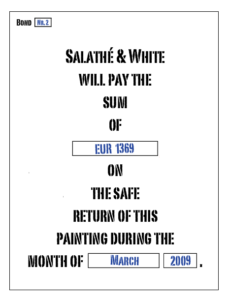 On the 17th of March 2008, I was the winner of the second collaborative bond painting (80cm x 60cm) that has been auctioned on ebay. The painting is a zero coupon bond created and signed by the swiss artist Marcel Salathé and the australian artist Anthony White. The artists guarantee to buy the painting back at a specific price, indicated on the painting, upon safe return during a specific month, also indicated on the painting. The summarized reasoning behind the Salathé & White bond paintings is that art is valued by the price someone is willing to pay, beauty is in the eye of the beholder and the longevity of an artwork is crucially depending on the first price paid. The complete manifesto is presented on the Salathé & White website.
On the 17th of March 2008, I was the winner of the second collaborative bond painting (80cm x 60cm) that has been auctioned on ebay. The painting is a zero coupon bond created and signed by the swiss artist Marcel Salathé and the australian artist Anthony White. The artists guarantee to buy the painting back at a specific price, indicated on the painting, upon safe return during a specific month, also indicated on the painting. The summarized reasoning behind the Salathé & White bond paintings is that art is valued by the price someone is willing to pay, beauty is in the eye of the beholder and the longevity of an artwork is crucially depending on the first price paid. The complete manifesto is presented on the Salathé & White website.
Marcel Salathé alias Sala is the creator of onethousandpaintings.com, an art project that has considerable success since its conception in 2006. More than 780 paintings have been sold and the project was presented in numerous blogs and in many high impact media publications.
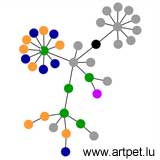
Webgraph
Sala is not only a famous artists, but also a biologist (with an ETH Medal for outstanding PhD thesis awarded 2007), a writer, a musician and a talented programmer. He is the author of the html-graph applet. Give it a try and see the tags in your webpage popping up like confetti.
Marcel Salathé’s reflections about the art market resulted in the following actions concerning his paintings :
- remove all content
- add minimum of uniqueness/limit
- led content become metacontent
- build in supply and demand mechanism
- create a price formula to stimulate the early market
price : y = f(x) = c(1000-x)
where
c-ceil(n + 1/100) * 0.1
and
n = number of paintings sold
On July 10th, 2008, Marcel Salathé was invited by Google TechTalks to talk about the Onethousandpaintings artwork. The video published on the YouTube googletechtalks channel is shown herafter.
https://www.youtube.com/watch?v=IIbyLlnKk9s
My daughter bought the Onethousandpainting Nr 658 mid 2006. It was the first painting sent to Luxembourg and one of the first work of conceptual art purchased by my daughter who owns a contemporary artgallery in Luxembourg. On August the 2nd, 2006, Luxembourg was welcomed as the24th country to the list of countries where paintings have been purchased on the blog of Marcel Salathé’s website.
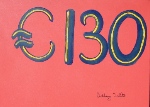
Money Series
Anthony White is best known for his “Money Series”, a project that he started using the Australian Dollar. The series has now been expanded to British Pounds, US Dollars and Euros, and over five hundred paintings have been sold to over twenty different countries in the past three years. On november 12th, 2007, I received my 130€ painting from the money series of Anthony White. It was the first painting that has been sent to Luxembourg.
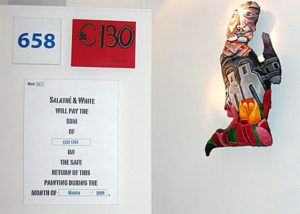 The combined paintings Salathé & White Bond Nr 2, the Onethousand-painting Nr 658 and the Money Series painting 130€ are exhibited at Leslie’s Artgallery, 66-68 rue de Luxembourg, L-6140 Bridel, Luxembourg. The gallery closed definitely early 2014.
The combined paintings Salathé & White Bond Nr 2, the Onethousand-painting Nr 658 and the Money Series painting 130€ are exhibited at Leslie’s Artgallery, 66-68 rue de Luxembourg, L-6140 Bridel, Luxembourg. The gallery closed definitely early 2014.
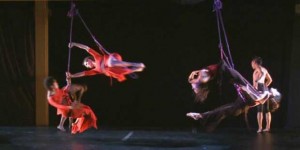
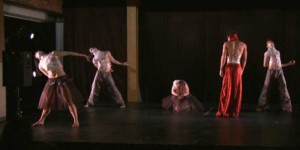
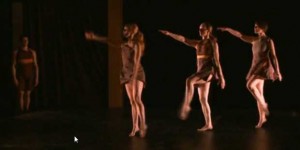
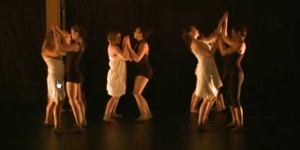




 The combined paintings Salathé & White Bond Nr 2, the Onethousand-painting Nr 658 and the Money Series painting 130€ are exhibited at
The combined paintings Salathé & White Bond Nr 2, the Onethousand-painting Nr 658 and the Money Series painting 130€ are exhibited at